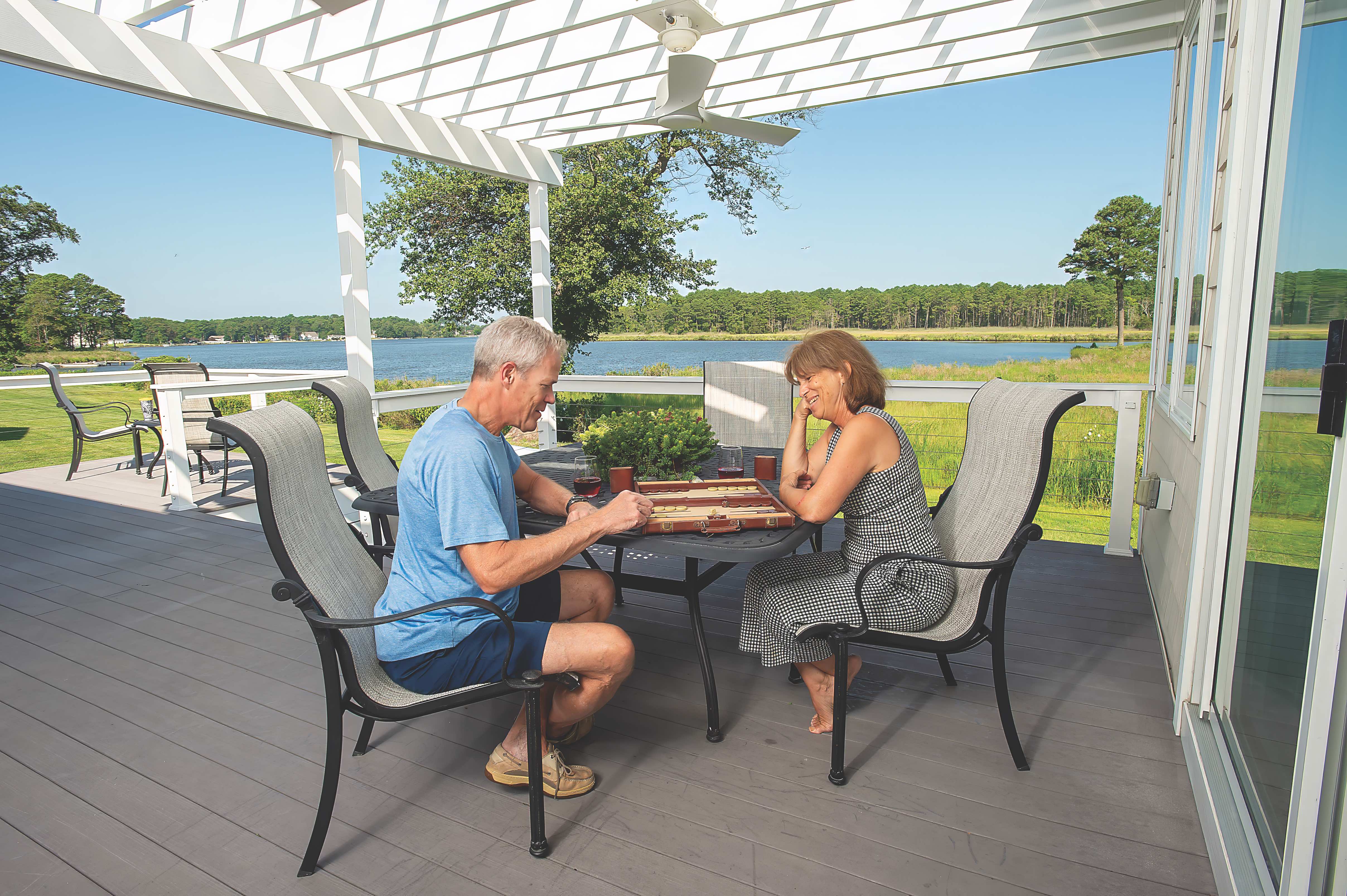
A slight price dip from 2022 heartens homebuyers, but other robust indicators cheer sellers
By Andrew Sharp
Photograph by Scott Nathan
From the October 2023 issue

Forty-five minutes after Mark and Cynthia Lotz toured the home on Dirickson Creek, they made their decision: They would put in an offer. The Harford County, Md., couple had been hunting for a second home and previously had their hearts set on one, only to lose out.
They didn’t want to see that happen again.
The Dirickson Creek location, not far from Assawoman Wildlife Area, didn’t match all of the goals they set when starting their search, which included being within walking distance to the beach and having a boat slip. “We had a checklist of, like, 10 things we were looking for and realized, we’re not going to get all that,” Mark explains. “We started to compromise [and] whittle away at our checklist.”
They had at first found a home they loved in Fenwick Island, though it was just outside their price range at $1.5 million. “We thought that the market was starting to soften a little bit at that point. So we put in a little bit of a lowball estimate with an escalation clause,” he says, referring to the buyer’s willingness to increase the offer should the seller receive a competing one that’s higher.
Their offer went nowhere and the house was sold to someone else.
While the homebuying frenzy that took hold during COVID is no longer what it was, to say that the market has cooled might be overstating things, as the Lotzes discovered. It’s not what it was last year, but it’s still significantly more robust than historical levels, according to both statistics and firsthand accounts from those in the local industry.
Things turned out well for this couple, though, as their offer on the Dirickson Creek home was accepted. “We absolutely love the place more than I could have imagined, so we’re very, very happy with the purchase,” Mark says.
The big picture
From Jan. 1 to June 30, the average selling price on homes in the 11 coastal Delaware ZIP codes declined about 4.8 percent compared to the same time period last year, according to data from Ocean Atlantic Sotheby’s International Realty. But the market in the first half of 2022 was, to use a layman’s term, berserk, so the slight reduction doesn’t mean homes here are a steal.
For example, the average selling price of $806,000 (down from $847,000 last year) for a single-family home in the first part of 2023 still dwarfs the average price in 2018 — $504,000. (As recently as 2021, the average was $693,000, more than $100,000 below the current number.) And in some places, prices actually increased over last year, notably the 19958 ZIP code that encompasses the city of Lewes and surrounding area, where the average price was up by 18.5 percent to $797,000. This area also far outpaced other ZIP codes in sales volume: In 19958, 413 single-family homes were sold; the next closest, 19966 (Millsboro area), had less than half that at 196.
As usual, the priciest ZIP codes were 19930 (Bethany area) and 19971 (Rehoboth-Dewey and the surrounding area), where average prices topped $1 million. The Fenwick Island average was over $1.5 million, but that number is skewed by the limited number of sales — only seven properties, all high-end.
At the other end of the price scale, the most affordable ZIP codes were Dagsboro and Milton, where average prices were around $500,000. Next lowest were Millville and Millsboro, in the low $500,000s.
Other key market indicators are sales volume and how long it takes properties to sell. Both showed modest dips overall from 2022: The number sold dropped from 1,417 to 1,228, a 13.3 percent decline; days-on-market rose from just over one month to just under two.
What’s played a role in this slight cooling trend? A variety of factors, including rising interest rates, as the Federal Reserve continues to combat inflation by increasing its benchmark interest rate. As a result, the rate for consumers now tops 7 percent — versus 5.5 percent in mid-summer 2022 — creating a dampening effect on the real estate market.
High demand
Rob and Leslie Strittmatter, who have lived in the Rehoboth area for more than a decade, have been on the hunt for a new property the past couple of years.
“If I remember, 13 years ago we had a lot of choices,” Rob recalls. “We were in and out of a lot of homes in the price range we were looking at.”
Now, things have changed. “There aren’t that many opportunities even in a higher price range in town or anywhere; it doesn’t seem like the inventory is there,” he says. “And it seems like properties are purchased within the day or even before they go on the market. … At least that’s been our experience.”
Leslie agrees. “The first house that we owned in town, what we paid for a five-bedroom, five-bath with a pool is now what it costs to just buy the lot.”
No, they agree on reflection, the lot actually would cost more than that now.
Conflicting forces are pushing against each other to create what appears at times to be a contradictory market.
For one thing, what seems like hordes of people still want to move into the area, with no signs of demand slowing. “There’s just so many baby boomers retiring; there’s so many of us in the same boat that are 60 to 70 years old that have saved our whole lives, and we’re ready to do something else,” says Mark Lotz, buyer of the Dirickson Creek home.
As the pandemic forced people to work remotely, it dawned on many of them that the beach area had internet service just as good as in cities.
Or as John Ciavarra, president of the DRB Group home-building operation based near Rehoboth, puts it, there were “more people that said, ‘Hey, I might be able to just go to Philly once a month or Baltimore once a month or my hub office, wherever it’s located, once a month. So it’s changed. Not fully, but we do see more families here.”
The bottom line is that demand is simply outstripping supply, even as new developments sprout out of cornfields seemingly overnight.
“What we’ve seen, at least, is resale inventory is still very low,” Ciavarra says. “And that’s helping new home sales tremendously, because [for] people looking for a new home, the resale market is kind of nonexistent.”
Robin Bunting, a Realtor at Compass Real Estate, notes that “there’s virtually nothing that exists that’s reasonable except for leased land,” referring to setups where buyers purchase simpler residences, such as mobile homes, but don’t own the land under them. (The Pot-Nets community along Delaware’s inland bays is a prime example.)
At the same time, rising interest rates are putting pressure on the market from the opposite direction, making it much more expensive to get loans. This is the primary reason local observers cite as a cause of the market slowdown, such as it is.
“Homes are definitely on the market longer,” Bunting says, noting that “it seemed like it slowed down a little bit last summer when the second-home interest rates went up.” But, she adds, the market is “still high-demand.”
Other real estate pros agree. “Currently, our amount of demand is greater than the supply, for sure,” says Justin Healy, a co-owner and broker at Ocean Atlantic.
It helps if an agent knows what you’re looking for, has connections, and can keep an eye out, the Strittmatters say, as word of mouth can play a big role in landing a home. Ocean Atlantic’s Kathleen Schell helped them find their ideal spot.
“Having someone that lives in the community, and knows the community, and knows everything that’s going on, is a huge benefit,” Leslie Strittmatter says.
A bit more balance
Despite this ongoing interest in beach-area homes, the market has evened out somewhat in the balance between buyers and sellers.
Healy remembers times “where the choice was between getting a property and not getting any property, and [buyers] were removing … contingencies and throwing caution to the wind.” That has eased.
“For a number of years, the market has just been go, go and ever increasing,” agrees Dan Thiewes of ReMax Coastal in Bethany Beach. This put pressure on buyers to make snap decisions, bidding on properties without carefully weighing whether the property was worth their offered price. Now, Thiewes says, the market has achieved a more ideal balance, with sellers needing to present their houses in the best light and buyers able — sometimes — to look at comparables and not rush in deciding “whether that’s the price they want to pay.”
This balance is a good thing, Thiewes adds. “The reality is we all want win-win. … I don’t want to overpay; you don’t want to undersell.”
At the same time, if Bunting comes across a house in fairly good shape, she has a caveat for clients who consider asking for a home inspection: “I have to caution you that if you do that you may not get the house.”
“If they’re in the right spot, priced correctly, not too low, not too high, they’re gone in three days,” says Steve Willis, a Realtor with Coldwell Banker in Ocean View.
Even the dampening effect from higher interest rates may eventually ease. Thiewes recalls that in the days of double-digit interest rates in the late 1970s and 1980s, buyers might see an 11 percent rate and get excited. “So what will happen is, once people adjust to the new norm or the new reality, they will purchase. When interest rates go down, they’ll refinance.”
Another strategy: Settle for a spot a little farther from the beach that’s less expensive.
Where is the market going?
While the housing market still seems strong, predicting too far into the future is risky. Consider the Great Recession: From January to June of 2009, just 385 homes (compared to 1,228 this year) were sold in the beach area, according to Ocean Atlantic’s figures. Those houses spent an average of 207 days on the market and cost an average of $521,000 — a far cry from this year’s $806,000 and 54 days to sell.
While the COVID-fueled market could not continue forever at its breakneck pace, for now the tectonic plates of market forces keep grinding against each other. Still, there can be positives for both buyers and sellers. In most years, it’s easy to state whether there’s a sellers’ market (high prices, high demand) or a buyers’ market (falling prices, lots of available homes). One could argue that this year it’s both — high average price for sellers (second year in a row over $800,000), yet for buyers that average price has fallen almost 5 percent since 2022.
The market always involves give and take. As Willis says, “If everybody could buy a house for under $200,000 and live 3 miles to the beach, everybody would.”



